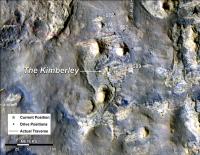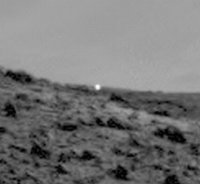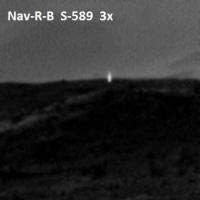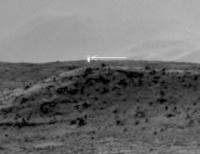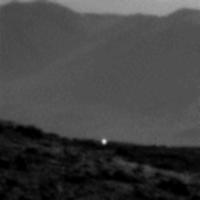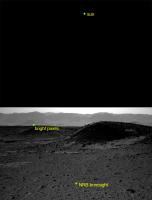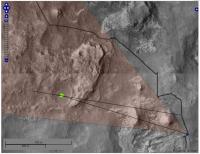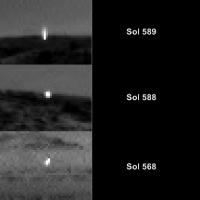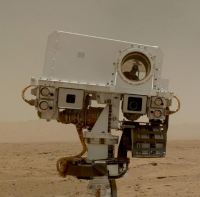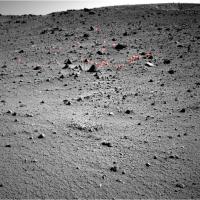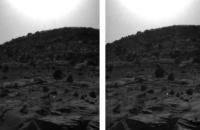Printable Version of Topic
Click here to view this topic in its original format
Unmanned Spaceflight.com _ MSL _ The sol 588 and 589 "strange bright lights" [sic]
Posted by: elakdawalla Apr 8 2014, 06:57 PM
In the past, unmannedspaceflight.com has provided a public service to debunk conspiracy claims by helping people locate and describe images related to the weird claim of the week. My favorite two examples of these were the "http://www.unmannedspaceflight.com/index.php?showtopic=4927" and the "http://www.unmannedspaceflight.com/index.php?showtopic=4277." In that spirit, I'm hereby providing links to images and other data related to this week's fun, originating with http://www.chron.com/news/strange-weird/article/NASA-photo-captures-strange-bright-light-coming-5382677.php, quoting a UFO enthusiast website. http://t.co/SD6JnjeobH, and http://t.co/RtHGtc5cy4.
Phil Plait http://www.slate.com/blogs/bad_astronomy/2014/04/08/curiosity_photo_light_seen_on_mars_is_a_camera_artifact_not_a_real_one.html and I took one look at it and said "cosmic ray hit." Here's the picture, right Navcam from sol 589:
http://curiosityrover.com/imgpoint.php?name=NRB_449790582EDR_F0310000NCAM00262M_
If you compare the image to the left eye taken at exactly the same moment, there is no bright pixel -- this is diagnostic of an event that affected only one camera, so is most likely a cosmic ray hit:
http://curiosityrover.com/imgpoint.php?name=NLB_449790582EDR_F0310000NCAM00262M_
Another thing that tells you it's likely a cosmic ray hit and not a bleeding pixel from something bright is the fact that pixel bleeding on Navcams happens in the horizontal, not vertical direction. Just check any http://www.midnightplanets.com/web/MSL/image/00589/NRB_449782783EDR_F0301366SAPP07612M_.html, or http://www.midnightplanets.com/web/MSL/image/00593/NRB_450148782EDR_F0310216NCAM00264M_.html in which the sloping side of the RTG is overexposed and bleeding horizontally. By contrast, cosmic ray hits can be oriented in any direction, such as in http://www.midnightplanets.com/web/MSL/image/00113/NLA_407549277EDR_F0050432NCAM00538M_.html.
And I figured my debunking work was done, until someone pointed out to me that there's another right Navcam image, shot from a similar but not identical location, at the same time of day, pointed in roughly the same direction, that also contains a bright dot. Here's the picture, right Navcam from sol 588:
http://curiosityrover.com/imgpoint.php?name=NRB_449700848EDR_F0301254NCAM00252M_
As with the sol 589 image, the bright dot is not in the Left Navcam frame taken simultaneously, although this time that fact is explained by the presence of a foreground butte blocking the field of view:
http://curiosityrover.com/imgpoint.php?name=NLB_449700848EDR_F0301254NCAM00252M_
This dot is different from the other one. It is not extended vertically. It's just a dot, that overlaps more than one pixel. Still, I would be inclined to dismiss this as a cosmic ray hit (saturating pixels, in one eye and not the other) without extraordinary evidence to the contrary. There are interesting coincidences here that could lend themselves to an alternative explanation, such as a specular reflection from a bright object: both are on the horizon, seen in the same direction, at the same time of day. But there is another coincidence that has me skeptical: seen in right eye only of the Navcam. And the vertical extension of the bright pixel in the sol 589 image just doesn't make sense for a specular glint; that would extend horizontally, not vertically, while cosmic ray hits can make streaks in any direction. So I am still inclined toward cosmic ray hits and coincidence, but I'll admit to being less totally certain about that after seeing the sol 588 image than I was after seeing the sol 589 image alone. http://www.nbcnews.com/science/space/nasa-explains-martian-flash-its-not-what-you-think-n74931:
"One possibility is that the light is the glint from a rock surface reflecting the sun. When these images were taken each day, the sun was in the same direction as the bright spot, west-northwest from the rover, and relatively low in the sky. The rover science team is also looking at the possibility that the bright spots could be sunlight reaching the camera's CCD directly through a vent hole in the camera housing, which has happened previously on other cameras on Curiosity and other Mars rovers when the geometry of the incoming sunlight relative to the camera is precisely aligned.
"We think it's either a vent-hole light leak or a glinty rock."
Anybody got anything else to add? Other images of this spot? Where is the spot on the map, exactly? I can (and have) drawn lines on Joe Knapp's map but I'm not convinced I understand the geometry precisely enough to want to say anything about where any putative reflective object would be.
Posted by: elakdawalla Apr 8 2014, 07:06 PM
Also, here are the visualizations from Joe Knapp's site of the viewsheds of the two images.
Sol 588:
http://planetary.s3.amazonaws.com/assets/images/4-mars/2014/20140408_NRB_449700848EDR_F0301254NCAM00252M_map_truthan.jpghttp://
Sol 589:
http://planetary.s3.amazonaws.com/assets/images/4-mars/2014/20140408_NRB_449790582EDR_F0310000NCAM00262M_map_truthan.jpg
Posted by: mhoward Apr 8 2014, 07:26 PM
Only thing I have to add: Many people here will remember, earlier in the mission, we had a whole discussion of sparkles that (I'm going to say now) probably were glints off rocks - because it seems like there were too many to be readily explained by bits of hardware laying around, and also we've seen a lot of polished, shiny rocks. I can't find the discussion at the moment. All of those glints appeared in both cameras, though (which is why we thought they might actually be interesting).
Posted by: fredk Apr 8 2014, 07:45 PM
I noticed the 588 blip at the time since it appears to sit on the distant ridge and doesn't obviously look like a cosmic ray hit (unlike the 589 blip, as you point out Emily). The lack of lnav to confirm it as a cosmic ray at first disappointed me. But then I remembered that (MSL especially) overlaps the navcams considerably. So the neighbouring rnav shows the same region as the 588 blip:
http://mars.jpl.nasa.gov/msl-raw-images/proj/msl/redops/ods/surface/sol/00588/opgs/edr/ncam/NRB_449700817EDR_F0301254NCAM00252M_.JPG
No surprise: no blip. My conclusion at the time: cosmic ray. I see nothing new here to change my mind.
Posted by: djellison Apr 8 2014, 07:52 PM
My very crude take on triangulation from the two Navcam images - put me in a spot that I think is also visible in one of the Sol 580 MastCam mosaics.... perhaps the tall thin rock left of center, near the top, on that rock face, is the cause of the excitement.
Sol 580 MastCam
http://mars.jpl.nasa.gov/msl-raw-images/msss/00580/mcam/0580MR0024070490400044E01_DXXX.jpg
That area is also visible on Sol 572 in Navcam - and that same rock is just about visible.
http://mars.jpl.nasa.gov/msl-raw-images/proj/msl/redops/ods/surface/sol/00572/opgs/edr/ncam/NRB_448279926EDR_F0300484NCAM00250M_.JPG
Posted by: freddo411 Apr 8 2014, 08:06 PM
Here's another "glint" from the right navcam, on sol 589. Also in the top left corner of the image, somewhat on the apparent horizon. Note the camera is pointing in completely different direction. Left camera shows no glint.
http://curiosityrover.com/imgpoint.php?name=NRB_449790644EDR_F0310000NCAM00262M_
Posted by: djellison Apr 8 2014, 08:15 PM
That glint is really nothing like the others in question - that really REALLY is a CR hit. It's nowhere near the local horizon. It's against the Gale crater wall some 25+km to the north.
Posted by: ngunn Apr 8 2014, 08:20 PM
How simultaneously are the navcam pairs taken? If there is even a small delay then one camera might miss a very small glint that was 'twinkling'. That seems unlikely but I can't think of any other way a real feature in the landscape could be missed by the other camera. It's surely too distant for the difference in viewing angle to come into play.
Posted by: djellison Apr 8 2014, 08:27 PM
Well - we have one pair where the feature is clearly hidden behind a nearby hill. The other pair is more curious - it may very well be the exact same situation - more local topography occluding it in one eye. I believe it's near instantaneous - the have the same spacecraft clock time time to the second.
Posted by: fredk Apr 8 2014, 08:41 PM
Here's a stretched, 200% zoom of the two 588 frames:
No hint of anything in the first frame. To repeat, I see no sign of anything other than cosmic rays. These aren't the blips you're looking for. Move along.
Posted by: neorobo Apr 8 2014, 08:59 PM
Depending on the smoothness of the surface, specular reflection is heavily dependent on the angle between the pixel and the surface normal of the object it's viewing. If the light reflected off the surface almost perfectly aligns with the camera, you will see the glint, otherwise you won't, even with a very small change in viewing angle between the two cameras.
It could be that one camera pixel or pixels is very closely aligned with the reflection angle, whereas the other camera is off slightly and little of the specular reflection travels to it comparatively. I'm not convinced that's it, as over several km the difference in viewing angle will be very small and would require a very very smooth surface. I'm not sure about the pixel bleeding that Emily is talking about either, I'll have to look into that. Just something to think about though.
Posted by: djellison Apr 8 2014, 09:00 PM
I was absolutely 100% "It's a CR hit" when I saw them. I've done a complete 180. 589 could be a CR hit. 588 isn't. It hides behind a hill behind the two eyes. It also happens to triangulate well with the Sol 580 MastCam and 589 Navcam feature to a tall, thin shiny rock.
Posted by: fredk Apr 8 2014, 09:16 PM
Huh? Do you mean that it's visible in 588 rnav but not 588 lnav? That's also consistent with a cosmic ray hit on the rnav and not the lnav! It's certainly not evidence that 588 is not a CR hit. And the fact that the other 588 rnav frame shows absolutely nothing also points to a CR.
Posted by: mhoward Apr 8 2014, 09:49 PM
One 'gleam' of hope for resolving this (ha ha): The area of the Sol 589 Navcam image was covered by Mastcam-100 on sol 590; only the thumbnail is available on the website at the moment.
Posted by: djellison Apr 8 2014, 09:54 PM
The Sol 588 observation ( visible in Right, not in Left ) is entirely consistent with an actual object being obscured by the perspective shift between the two eyes applied to the northern side of the nearby topography.
The Sol 589 observation does not have a similar topography to explain it's one-eye appearance (although a small rock on the nearby topography might explain it )
However, if one triangulates between the two observations, one finds a point on a small ridge line. That point is also visible in Sol 580 MastCam imagery that shows a tall, thing, bright rock at the exact same point ( see my first post on this thread )
This means either....
1) 2 CR hits happened to appear on two images on the same camera on two sols at different pixel locations that happens to be geometrically consistent with a tall thin bright rock see 8 sols earlier ( which is QUITE a coincidence )
2) It's an actual thing.
I'd expect M100/M35 and ChemCam imagery of the same spot to be acquired soon that should quite easily settle the matter. The object, if it's real, is approx 160 meters away.
Posted by: elakdawalla Apr 8 2014, 11:25 PM
Where would it be in the sol 593 late afternoon Navcams? Behind the butte?
Edit:
http://curiosityrover.com/imgpoint.php?name=NRB_449790644EDR_F0310000NCAM00262M_
Although the "light leak" notion of Justin's is my least favorite explanation, I'll note that the bright pixel in the image that freddo411 points out is also in the upper leftish area of a right Navcam image so could be investigated as light-leak-related. But if it were that easy to make a bright pixel with a light leak, we'd see them in a lot more images, I'd think.
Posted by: djellison Apr 9 2014, 12:18 AM
The rock I think we're seeing glinting is also visible in Sol 582 MastCam as well.
MR - Sol 582
http://mars.jpl.nasa.gov/msl-raw-images/msss/00582/mcam/0582MR0024340330400325E01_DXXX.jpg
MR - Sol 580
http://mars.jpl.nasa.gov/msl-raw-images/msss/00580/mcam/0580MR0024070490400044E01_DXXX.jpg
Posted by: elakdawalla Apr 9 2014, 12:33 AM
Boy, would I like to see less-JPEGgy versions of those images...
Posted by: PDP8E Apr 9 2014, 12:56 AM
Me too! Here is a lightly rinsed 3x ... really looks like a CR ... your mileage may vary
Doug, there is that rock off to the left on the ridge,in the image you posted:
MR - Sol 582 (2 posts up)
Posted by: fredk Apr 9 2014, 12:59 AM
The 589 blip is very clearly a CR. Note that the bright pixels extend above the far outcrop and are set against the distant Gale rim - see the arrowed part here:
As Emily pointed out in the first post, navcam bleeds horizontally. (This doesn't look like bleeding anyway!) How else could we be seeing bright pixels above the outcrop in question? CRs often form streaks that look very similar to this.
This view also shows that the bright blip/streak is above the outcrop with flattish rock Doug identified above.
Therefore there is nothing to triangulate 588 with. It seems like a stretch to imagine that one of the 588 frames caught a glint off a distant rock and the other 30 seconds earlier didn't.
The other problem is that we have never seen mirror-like specular reflections from large surfaces on Mars. Even if a surface was somehow smooth and flat enough, dust tends to cover surfaces.
If it looks like a CR, and quacks like a CR, and occam's razor dictates it's a CR, then...
Posted by: atomoid Apr 9 2014, 01:01 AM
excellent sleuthing, especially on locating the candidate rock face! its still hard to see what exactly is the nature of that rock..? http://gettn-sirius-about-startrek.wikispaces.com/For+the+World+is+Hollow+and+I+Have+Touched+the+Sky
It still seems so unlikely for a glint showing up only in the Right eye, but not in the left eye that's just a few inches away yet does appear the previous day in a separate location, though the different shape of the glint is consistent with that, if there were to be two faces of the rock that happened to be configured perfectly for sending reflections to these two locations..
zoomed non-interp 400% shows it blends into image as if its being resolved through the lens.. http://www.midnightplanets.com/web/MSL/image/00588/NRB_449700848EDR_F0301254NCAM00252M_.html on left http://www.midnightplanets.com/web/MSL/image/00589/NRB_449790582EDR_F0310000NCAM00262M_.html on right
Posted by: MarsInMyLifetime Apr 9 2014, 02:23 AM
What percentage of the cruise stage may have survived entry and dropped short of the "flown" EDL path? I'd expect any such parts to be small and well ablated, not visibly shiny, but this spot does seem to be in the possible strew field for that stage. I'm not willing to push this idea very hard--I lean towards the CR explanation as well, but Mars EDL being as untidy as it is...
Posted by: PDP8E Apr 9 2014, 03:04 AM
The glint on sol 588 does not appear to be a CR !
Here is a straight forward bi-cubic spline 6x image from the original...
the bright spot is concentrated on a central pixel on a ridge ...
The wall of Gale is also in the image, anyone that can triangulate (from the original 588 Nav R B ) may get closer to the 'rock'
Posted by: DLC Apr 9 2014, 03:36 AM
Is it ice?
The vertical, light-colored feature seen in the mastcam 580 image looks to me to be a good candidate for something like the well-known Mars gullies, caught in the act.
Consider:
It appears to be precisely vertical, and lighter in color than anything else in the frame, consistent with ice or flowing water.
It extends from the rim-edge of a portion of what appears to be the crater wall.
It appears to be in the same vicinity as something that seems to be producing unusually pronounced specular reflections.
It looks an awful lot like a waterfall or frozen waterfall, and we know that seasonal gullies are seen on Mars. Have any been seen at this latitude or in this vicinity?
It seems that the JPL folks are just saying specular reflection, at this point. That's consistent, and appropriate.
Posted by: djellison Apr 9 2014, 03:57 AM
No. It's also visible in two MastCam images from 6 and 8 days earlier - and it's clearly a well wind polished rock.
A large expanse of ice like that would have sublimated away long, long ago.
Posted by: fredk Apr 9 2014, 04:01 AM
On what basis do you say that? CR's can take on a wide range of appearances - have a look at some low-light navcams or better nighttime navcams.
Seriously, the speculation is getting a bit out of hand here. There are better places for this kind of discussion...
Posted by: nprev Apr 9 2014, 04:12 AM
Is this (possible) thing anywhere near the planned traverse path? The mainstream media is going nuts about it; might be worth a side trip just to let the hot air out of the loonies.
Posted by: elakdawalla Apr 9 2014, 04:22 AM
No, it's not near the planned path, and no, it's not worth a side trip. It's either a cosmic ray hit, or something in RNav optics, or a shiny rock. None of those things would warrant taking Curiosity away from the planned path.
Posted by: nprev Apr 9 2014, 04:52 AM
Agree scientifically, of course. Too bad, though; great opportunity to place some well-deserved egg on the right faces.
Posted by: djellison Apr 9 2014, 05:20 AM
Such as JPL perhaps where today Justin Maki, engineering camera team lead, has said a shiny rock 160m from Curiosity is a perfectly plausible explanation, as well as a possible navcam light leak or CR hits.
I appreciate your emphasis on keeping the woo out of UMSF, but your repeated demands to shut down the discussion is at odds with mainstream thinking on the issue.
Posted by: vikingmars Apr 9 2014, 07:26 AM
Could some "candidates" be seen from orbit on HiRISE images ? Or are they too small ?
Posted by: xflare Apr 9 2014, 07:39 AM
Everyone likes solving mysteries
The candidate rock even looks quite bright in that mastcam image.
Posted by: monitorlizard Apr 9 2014, 09:21 AM
Something that shiny makes me think of iron-nickel meteorites, which can be essentially pure metal. We already know there are meteorites on Mars. If it isn't too old, it
would not have oxidized the surface yet (which would take much longer on Mars than Earth).
Posted by: Ant103 Apr 9 2014, 09:38 AM
I can hardly think it's a reflexion from a distant object. The parallax between the two Navcam is too close to have a very bright spot in one, an none in the other.
Let me explain : On Earth, when you are looking to a city in sunlight, sometimes there is a specular reflexion coming from a window or a large panel of bright metal. This reflexion don't disappear if you just moving less than a meter. Or the object that is reflecting the sun have to be a few centimeters large, with a very plane surface (typically : a mirror). I doubt that on Mars such a rock exist : very plane and very reflective in the same time. They can be flat, but not as flat as mirror. Because the surface aspect is certainly not a perfect plane, the light beam could not be so tight. And just because of that, if it was actually a reflexion from a rock, it should have been saw by the TWO camera, not one.
For me it's just a cosmic ray hit, maliciously place by coincidence on a particularly place, but it's just cosmic rays.
Posted by: ngunn Apr 9 2014, 09:43 AM
They're shiny [iron meteorites] but rarely have perfectly flat faces. I'd prefer very large single crystals, possibly feldspar, in the unlikely event that these are real landscape features.
Posted by: ustrax Apr 9 2014, 09:48 AM
It's baaack...
http://i16.photobucket.com/albums/b14/ustrax3/nru4.jpg
Posted by: jmknapp Apr 9 2014, 11:25 AM
Some basic geometry of the situation using SPICE:
Raw image: http://mars.jpl.nasa.gov/msl-raw-images/proj/msl/redops/ods/surface/sol/00589/opgs/edr/ncam/NRB_449790582EDR_F0310000NCAM00262M_.JPG
http://curiosityrover.com/imgpoint.php?name=NRB_449790582EDR_F0310000NCAM00262M_
time of shot: sol 589 03:08:07 P.M. LMST (2014 APR 03 10:00:03 UTC) et = 449791270
NRB boresight direction (azimuth, elevation): 298.81° -16.86°
Direction of bright pixels: 286.06° 0.67°
Sun position: 300.33° 31.79°
So the sun position relative to the line from the camera to the bright pixels is 14.27° northward and 31.12° up.
Kind of interesting (coincidence?) that the pixels are within a degree of horizontal.
EDIT: Also, if it is the same object in both images, here's my attempt at triangulation:
Posted by: Gerald Apr 9 2014, 01:12 PM
Do the two lines of sight intersect in 3d space?
Posted by: centsworth_II Apr 9 2014, 01:25 PM
It seems that the intersection of those two of those lines is in mid air above the bowl of that crater.
Posted by: djellison Apr 9 2014, 01:41 PM
That triangulation matches, by my estimation, the tall, thin, bright, shiny feature seen in these Mastcam images a week earlier.
http://mars.jpl.nasa.gov/msl-raw-images/msss/00582/mcam/0582MR0024340330400325E01_DXXX.jpg
http://mars.jpl.nasa.gov/msl-raw-images/msss/00580/mcam/0580MR0024070490400044E01_DXXX.jpg
It will also be in this image once down linked at full res
http://marsmobile.jpl.nasa.gov/msl/multimedia/raw/?rawid=0590MR0024830370400509I01_DXXX&s=590
Posted by: john_s Apr 9 2014, 01:59 PM
Tall and thin, indeed. Bright and shiny? Not so sure. It looks to me like an rock of unusual shape but ordinary color and brightness, that just happens to have a vertical face oriented to catch the light in that shot.
John
Posted by: fredk Apr 9 2014, 02:02 PM
http://i16.photobucket.com/albums/b14/ustrax3/nru4.jpg
Hah!
At least the Beacon didn't appear and disappear like... like... you know it's coming... a cosmic ray!
Posted by: marswiggle Apr 9 2014, 02:21 PM
After individually rotating and resizing each of those R navcam images, cropping the pair, enlarging 1.5 x, vertically stretching 2 x, and sharpening a bit for good measure, I think I can discern the ridge at 150 m (late edit: probably farther off, 200 m or so) distance in both images as an arched outline at the center. This comparison also works as a crude cross-eyed pair. The bright spots do not seem to be located at or near the ridge, instead being unrelated to it and to each other as well. Don't know how much this helps though.
Posted by: elakdawalla Apr 9 2014, 03:08 PM
I'm still having a hard time thinking of the sol 589 one as anything but a cosmic ray hit; it extends several pixels above the horizon, onto the distant hills.
It did occur to me while awake last night (as these things do) that you could make a singularly bright vertical rock face by exposing the planar surface of a gypsum vein. Still, I would expect more than one such feature to show up, and I would expect it to be visible to both eyes, and it should not have that vertical extension. So I just don't like it.
Posted by: marsophile Apr 9 2014, 03:55 PM
If the vein was inside a narrow crack between two rocks, then a glint from it would only be visible within a very narrow viewing angle.
Posted by: jmknapp Apr 9 2014, 04:02 PM
If the sun is 30 degrees above the horizon and the reflected ray is even with the horizon, wouldn't that imply that the reflecting surface/point is oriented 15 degrees from the horizon? I.e., relatively horizontal.
Posted by: Gerald Apr 9 2014, 04:23 PM
If it's just one surface, yes, but it if it's actually a reflexion it could also be a reflection of e.g. two planes in different angles.
[About possible reflecting surfaces on Mars] A cleavage of feldspar might cause plane reflecting surfaces, too.
[About the position estimate] A relative pointing error of 1° could move the intersection of the two lines in Joe's graphic to the hill in front. But after trying to estimate the error ellipse of Joe's cross bearing by using the parallax of the bright pixels relative to background rim features as a partly independent measurement, I got a distance of 176 m relative to the Sol 588 position; that's very close to the position in Joe's graphic. This may still be wrong, or there might have been two independent reflexions. Nevertheless, I'm now prefering coincidental CR hits as most likely, as well.
(The second graphics is Joe's graphics with some additional annotations.)
Camera artifacts (straylight, hot pixels) should follow some reproducible rule, which I can't yet recognize.
Posted by: jmknapp Apr 9 2014, 06:07 PM
My triangulation could easily be 1 degree off. The direction of the boresight (center of image) is pretty reliable (as reliable as the SPICE kernel anyway) but to get the direction of the bright pixels I just counted pixels from the center assuming a uniform field of view of 45.33° and that the rover was level (which it fortunately was to within about a degree). So any lens distortion could throw it off too. It could be done more precisely if warranted, BUT how about this argument: if it was some kind of specular reflection that was so sensitive to direction that one NAVCAM saw it but the other didn't, and it was 176m away as Gerald figures above, then a 42 cm shift in baseline (0.13°) is the difference between seeing and not seeing. The sun for its part moves 0.13° in about 45 seconds. So then what are the odds that the thing would be seen twice on different sols from different positions? Pretty low right? Therefore by Ockham's Razor it's not a reflection.
Posted by: testguru Apr 9 2014, 07:16 PM
Is there any chance to do time lapse photography of the area in question? Zooming in to the area with 64X64 or 256X256 pixel coverage should not overburden the uplink bandwidth I would think
and a resultant "movie" with ~ 1 sec intervals should catch any reflections. Also doing this at night would be interesting.
I have wished for a meteor watch movie at night but don't know if the rover has this capability or not. In October it would be really interesting to see if a meteor storm happens.
Posted by: Phil Stooke Apr 9 2014, 07:47 PM
The experience with Spirit was that meteor searches revealed only cosmic rays. Even things thought at first to be meteors couldn't be confirmed in the end to be anything but cosmic rays. And presumably a search would be done with the Navcams, for the wider field of view, so basically the same cameras. So it may not be useful, and certainly would be a low priority... except, as you say, in October, which is a special time.
Phil
Posted by: jmknapp Apr 9 2014, 08:10 PM
Pretty much. I did a more careful determination of the directions taking into account the non-levelness of the rover at the two spots.
sol 588 02:52:33 P.M. LMST NRB_449700848EDR_F0301254NCAM00252M_ azimuth and elevation: 278.51° 0.26°
sol 589 03:08:07 P.M. LMST NRB_449790582EDR_F0310000NCAM00262M_ azimuth and elevation: 286.80° 0.45°
It's remarkable that the elevation of the thing is within a degree of horizontal in both cases. Another odd coincidence: the center of the camera in both cases was pointing to very nearly the same az/el:
camera boresight az/el:
sol 588: 298.59° -16.90°
sol 589: 298.81° -16.86°
The XYZ position of the rover in meters relative to the landing site:
sol 588: -2371.1 -2895.0 39.8
sol 589: -2360.7 -2923.2 39.2
From the XYZ positions and the directions to the thing it's possible to calculate how close the two vectors come to intersecting each other at the closest point, as well as the location. My head is starting to hurt right now though!
EDIT: here is the refined position, closer to the ridge:
The range of the crossover point is 184 meters, and the lines come within 4 cm (!) of intersecting as my calculations have it anyway. A real mystery. Here's a picture:
The coordinates are meters relative to the landing site. Note the vertical scale is greatly exaggerated compared to the horizontal axes.
Posted by: Thorsten Denk Apr 9 2014, 08:41 PM
The normal vector of the surface would be tilted 15 degrees from horizontal,
that means the reflecting surface is close to vertical.
Thorsten
Posted by: jmknapp Apr 9 2014, 09:08 PM
that means the reflecting surface is close to vertical.
I don't think so--here's the situation, roughly:
Posted by: freddo411 Apr 9 2014, 09:13 PM
I went looking through images hoping to find other "cosmic ray hits" and/or "hot pixels" or even perhaps any other anomalies that might be compared and contrasted with the "big glint".
I came up with this "hot pixel" at postion 934 horiz and 28 vertical in the right NAVCAM. It appears overly "bright" compared to its surroundings. The two frames were shot 31 seconds apart. This leads me to understand this as a defect in that pixel of the detector.
http://mars.jpl.nasa.gov/msl-raw-images/proj/msl/redops/ods/surface/sol/00593/opgs/edr/ncam/NRB_450140205EDR_F0310216NCAM00263M_.JPG
http://mars.jpl.nasa.gov/msl-raw-images/proj/msl/redops/ods/surface/sol/00593/opgs/edr/ncam/NRB_450140236EDR_F0310216NCAM00263M_.JPG
this hot pixel appears in other shots as well. This is not at all like the "glint"; this is presented as contrasting information.
My short visual search of 100 or so NAVCAM images did not show any anomalies like the two observed "glints".
Posted by: Thorsten Denk Apr 9 2014, 09:56 PM
You're right Joe, azimuth matters.
I was thinking in the sun behind the rover,
but it was in front of her.
Posted by: djellison Apr 9 2014, 10:02 PM
Bandwidth is rarely a constraint on activities such as this. Time available in the rovers schedule as well as power is the limit. Consider - while the rover is doing this, it can't be driving / doing other remote sensing / using the arm etc etc. Moreover, the mast can not be pointed sunward for extended periods - there are rules that constrain the duration of sun-pointed activity to avoid damaging ChemCam's optics.
Posted by: atomoid Apr 9 2014, 11:33 PM
Heres a crosseye of the candidate rock images posted earlier to get better sense of contour, yep the bright side points to the right, but I still think its http://gettn-sirius-about-startrek.wikispaces.com/For+the+World+is+Hollow+and+I+Have+Touched+the+Sky theres even the pentagonal platform complete with steps at near right and some sort of little crucifix offering near lower left.
Posted by: BKing Apr 10 2014, 12:43 AM
Looong time lurker un-cloaking to say thanks atomoid for that x-eyed. I turned it into a flicker GIF (not sure if this will work, first upload.)
in which it appears what we are seeing is the sunlit end of a chopped off 'toe' of rock that is lying in front of that wall. The bright end would be the 'cut' pointing towards the Sun, away from Curiosity on Sol 589. That glinty edge is facing the cliff from this view.
Edit: Thanks folks for 12 years of Mars exploration.
Posted by: Gerald Apr 10 2014, 01:23 PM
With your revised coordinates I got a distance of 166.4 m from Sol 588 position, and 182.8 m from Sol 589 position, resulting in a distance between the two lines of 8 cm.
The minor discrepancies to your result may be due to different numerical truncations or changed pointing of the rover (which I neglected).
I'd say, based on the revised data, and calculations assumed to be correct, the lines intersect within the precision of measurement.
May be it's worth to check the positions in the MastCam images once again...
Posted by: ronatu Apr 10 2014, 02:49 PM
Could it be gas eruption?
Dust diavol?
Posted by: Ant103 Apr 10 2014, 03:06 PM
Impossible : it should have been saw by all the Navcam. And it's not the case.
Posted by: djellison Apr 10 2014, 03:34 PM
Dust Devil? We know what those look like, and it's not that.
Posted by: Gerald Apr 10 2014, 03:54 PM
If it's a "real" object, there are quite a couple of possibilities, besides veins, polished basaltic or sedimentary rocks, or crushed crystals.
The estimated location is close to an impact crater. So molten sandstone could be one more option; in some cases the melt forms http://geology.com/meteorites/images/libyan-desert-glass-2-750.jpg, which might have been polished by dust, and be able to reflect sunlight. The surface of such a polished glass could be close enough to horizontal to allow a direct reflection of sunlight to the camera. Due to different perspectives it may sometimes be hidden by rocks several meters in front of, even from slightly different angles, plausible at least for the Sol 588 NavCam pair.
Posted by: DLC Apr 10 2014, 04:08 PM
camera boresight az/el:
sol 588: 298.59° -16.90°
sol 589: 298.81° -16.86°
Does that precise alignment support the idea, mentioned by JPL's Justin Maki, that this might be a light leak through a camera vent hole? The coincidence does seem striking.
Posted by: jmknapp Apr 10 2014, 04:45 PM
That's what I'm thinking, although I don't have a good idea of how that explanation goes. It's just that a reflection seems so unlikely, as any of the hypothesized reflecting surfaces (faces of rocks, gypsum veins, dust devils, plumes, etc.) would have to be so sensitive to direction to not appear in both cameras but be caught on two successive days. And two cosmic ray hits that just happen to conspire to triangulate to the same point in 3d space?? So that leaves the light leak idea among the explanations offered. The LMST of the two shots differs by 15 minutes though.
Posted by: Gerald Apr 10 2014, 04:52 PM
I'd say, if the different position of the bright pixels can be related to the slightly different position of the sun and the rotation of the camera, this could influence the assessment - in either direction.
After subtracting the rotation of the camera the position of the bright pixels should follow the position of the sun. Since the images have been taken in the afternoon the motion should have been rather diagonal, not horizontal, as observed.
From this I'd almost rule out, that the same vent hole could have caused the two occurences of bright pixels.
Posted by: vikingmars Apr 10 2014, 08:25 PM
This "strange bright light" event is now becoming a worldwide "affair" and I was called twice today by the French Press which is now aware of it through the Internet buzz...
The best way to solve this and stop the beginning of what is felt as new conspiration theories would be for the MSL team to have a quick drive at the rock if that's not too far away (I understand 1-2 days drive), have a quick look at it and resume the rovers operations.
Like many people involved in EPO, I guess, I'm now tired seeing good Mars science diverted with "non-science" theories ![]()
Posted by: anticitizen2 Apr 10 2014, 08:31 PM
No way, there's going to be something weird in another picture next week.
The hype has nothing to do except die out because it is nothing exciting in reality. Maybe mineral, maybe camera, certainly wild goose chase.
Besides, it is away from the mountain... That is what the mission is here for.
I'm sure we're all feeling similarly anxious about the attention, and I wish the grounded excitement of real exploration were enough for the general media!
Posted by: elakdawalla Apr 10 2014, 08:38 PM
What anticitizen2 said. The robot is on Mars to do science, not to chase will-o'-the-wisps. And this website is for analyzing images, not advising rover drivers. In this thread, please let's stick to what we do well: image analysis.
Posted by: algorithm Apr 10 2014, 08:46 PM
If I were the NASA chap in charge of persuading the US govrnment to give me some more tax payers money then I would be wringing my hands with delight right now.
The tax payers fund this, the government allocate the money, the greater the interest the greater the demand to continue funding from the tax payer.
Be very greatful for any interest from the wider 'busy with their own lives' tax payer you can get!!
Being an Englishman I can tell you that I wish for UFOs' flying over The Houses Of Parliament every day!!
Posted by: MarsInMyLifetime Apr 10 2014, 08:59 PM
I hope this applies to your guideline, Emily. I fix old bellows cameras and make pinhole cameras and have Raleigh-tested my own mirror blank, so this is what I can offer on the light leak school of causes:
Light leaks always tend to be diffuse (raising the fog on the sensor) unless there is a point source projected directly onto the sensor's surface by a pinhole. The single-pixel nature of the spots is also problematic for the pinhole projection scenario--diffraction effects will broaden the beam to a diffuse disk, wherein the smaller the pinhole, the more the diffusion, even for a projected point source. (Pinhole photography is an artful balance between improving sharpness vs diminishing contrast.) Either way, deriving a saturated, cleanly single-pixel image by reason of a light leak seems improbable.
The more likely reasons for single bright pixels discussed so for are either cosmic ray hits or a point reflection that was imaged by the optics. And that comes down to which is more likely: for a cosmic ray to intercept the imaged horizon in each exposure, or for a glint to miss the same camera inches away at each exposure. Without more information, I don't think any option is provable. But light leaks are NOT on my table.
Posted by: djellison Apr 10 2014, 09:24 PM
Burning a couple of weeks ( 160 m there, 160m back...that's 1/3 of a km wasted, a few $10M's worth of MSL's prime mission ) would, truly, be diverting away from science.
Moreover - such observations would not silence any conspiratorial dialogue.
We have more MastCam images due to come down of that spot - which will probably show that rock isn't the culprit, leaving us utterly with benign imaging artifact explanations. Time to move on, and get some science done.
Posted by: mcaplinger Apr 10 2014, 09:33 PM
If you look at the bench photos of the Navcams in Figure 3 of http://www.lpi.usra.edu/meetings/lpsc2011/pdf/2738.pdf you can see a small black round object adjacent to the lens. A better picture is at http://mars.jpl.nasa.gov/msl/news/images/MSL_cams.jpg I believe that's the vent Justin mentioned. No, dust can't leak through, and I'd have thought that a light leak would be unlikely but perhaps not impossible.
Posted by: ngunn Apr 10 2014, 09:33 PM
Just a stray thought because I've not seen it mentioned. The two 'bright lights' may have different explanations. One cosmic ray hitting close to a different interesting feature is not too much of a coincidence.
Posted by: Gerald Apr 10 2014, 11:22 PM
A NavCam image FOV is about 45°, and 1024 pixels wide; the sun has an apparent diameter of a little less than 0.4°, hence less than 11 pixels diameter in a NavCam image.
To visualize this, here http://mars.jpl.nasa.gov/msl-raw-images/proj/msl/redops/ods/surface/sol/00589/opgs/edr/ncam/NRB_449782783EDR_F0301366SAPP07612M_.JPG annotated with an upper bound for the size of the sun (red disk):
This means, although pixel bleeding is horizontal in NavCam images, a bright source of light can involve surrounding pixels; this could explain, how pixels can be bright above the potential object.
The area of the bright pixels relative to the bright area caused by the sun could reveal the minimal size of a potential reflecting object (dependent of its albedo/specularity/reflectance), knowing the approximate distance.
EDIT:
The bright area in the Sol589 image is about 20 pixels, corresponding to a disc of a diameter of about 5 pixels.
The bright area in the NavCam image of the sun is about 15 times the diameter of the apparent diameter of the sun.
Dividing the 5 pixels diameter of the Sol589 image by 15, we get about 1/3 pixel minimal apparent diameter of a reflecting object.
That corresponds to about 45° * 1/3 / 1024 = 0.015°.
On a distance of 170m this corresponds to a circle with diameter of about 170 m * tan(0.015°) = 4.3 cm.
Dividing this by cos(15°) due to the angle relative to the camera, we get an ellipse of about 16.6 cm x 4.3 cm as an estimate for the minimal size of a reflecting surface which cold cause the observed effect.
Hence, if it's a real object, it may be a vein or a pebble of just this size, not necessarily much larger.
Posted by: jmknapp Apr 11 2014, 12:43 AM
Another example of a bright spot in NRB but not NLB, back on sol 568 (March 12th):
http://mars.jpl.nasa.gov/msl-raw-images/proj/msl/redops/ods/surface/sol/00568/opgs/edr/ncam/NRB_447920587EDR_F0291020NCAM00295M_.JPG http://curiosityrover.com/imgpoint.php?name=NRB_447920587EDR_F0291020NCAM00295M_
http://mars.jpl.nasa.gov/msl-raw-images/proj/msl/redops/ods/surface/sol/00568/opgs/edr/ncam/NLB_447920587EDR_F0291020NCAM00295M_.JPG http://curiosityrover.com/imgpoint.php?name=NLB_447920587EDR_F0291020NCAM00295M_
It's in the same approximate area of the frame as the present two examples, and also NRB only, pointing toward a camera issue?
Posted by: JohnVV Apr 11 2014, 12:52 AM
a good article that pretty much puts this to rest
http://www.slate.com/blogs/bad_astronomy/2014/04/08/curiosity_photo_light_seen_on_mars_is_a_camera_artifact_not_a_real_one.html
Posted by: elakdawalla Apr 11 2014, 01:01 AM
Ha, he wrote that article after asking me about it, when I'd only seen the sol 589 one, and I assured him it was a cosmic ray. It was after I'd also seen the sol 588 one that I started this thread.
Posted by: elakdawalla Apr 11 2014, 01:03 AM
It's in the same approximate area of the frame as the present two examples, and also NRB only, pointing toward a camera issue?
Oh, well spotted.
Posted by: atomoid Apr 11 2014, 01:44 AM
indeed, and to think I spent probably an hour fruitlessly combing through navcams (not saying that's wasted time though!), yes good catch.
on the flank of mt Sharp no less, definitely not the hypothesized rock of recent yore.. though im still convinced that represents the salvaged wreckage of the http://gettn-sirius-about-startrek.wikispaces.com/For+the+World+is+Hollow+and+I+Have+Touched+the+Sky.
Phil Plait's http://www.slate.com/blogs/bad_astronomy/2014/04/08/curiosity_photo_light_seen_on_mars_is_a_camera_artifact_not_a_real_one.html linked another one 'over a rock' http://www.midnightplanets.com/web/MSL/image/00107/0107MR0682028000E1_DXXX.html at middle right as well.. definitely willow-the-wisp.. or a Lowly Photon.... recalling http://www.unmannedspaceflight.com/index.php?s=&showtopic=7535&view=findpost&p=194762 from the glenelg days...
Posted by: djellison Apr 11 2014, 03:56 AM
That's very compelling!
Posted by: jmknapp Apr 11 2014, 08:40 AM
Mainly culled than spotted. By my count there are over 17,000 NRB images and these artifacts are somewhat rare. So I wrote a little program to detect isolated small bright spots in an image. That only winnowed the total number of candidates down to about 2,500, mostly because any time the rover is in the frame there are very likely to be isolated bright spots. So then I said just look at the top third of the frame to eliminate most of the rover false positives. That got the number down to 180, most of which featured the UHF antenna which still poked up into the top of the frame. But our two favorite images were in there along with the third from sol 568.
Posted by: ngunn Apr 11 2014, 09:02 AM
Brilliant work. Hats off!! ![]()
Posted by: Gerald Apr 11 2014, 09:11 AM
The bearing is to the east, a very different angle relative to the sun. A vent hole should be unlikely for this image.
Edit: Survey of the three (due to Joe's great job!) blips, magnified 4x:
Posted by: jmknapp Apr 11 2014, 07:46 PM
Maybe so--but I'm not sure how a light leak is supposed to light up just a few pixels anyway, so maybe the mechanism isn't straightforward.
BTW, Phil Plait has a mea culpa today on Slate:
http://www.slate.com/blogs/bad_astronomy/2014/04/11/better_living_through_errors_what_i_learned_from_being_wrong_this_week.html
That's an important lesson, that the object of science is not foremost to debunk, and come up with a plausible but hasty explanation, but rather to figure out what the explanation is.
I have to agree with algorithm above:
I noticed the traffic to my raw image web site doubled in the last few days, no doubt similar to what happened at all Mars-related web sites. A side benefit is that the recent images show some classically pretty terrain and formations and these have gotten wide exposure under the cover of looking for the bright pixels.
Posted by: djellison Apr 11 2014, 07:55 PM
Were that argument to hold water, we would have been back to the moon a thousand times since 1969, and the popular formation in Cydonia would be knee deep in spacecraft.
Posted by: nprev Apr 11 2014, 08:44 PM
Agreed. The nine-day wonder effect is extremely limited for anomalies. It's also qualitatively different than the blip of media interest that inevitably occurs for events such as planetary landings; the former is a 'gee whiz', the latter is an achievement. Different emotional sets.
Even more significantly, the latter influences decision-makers much more profoundly.
Posted by: jmknapp Apr 11 2014, 08:45 PM
Well, we have been to Mars 11 times plus several unfortunate losses, with an impressive infrastructure currently of orbiters and two active rovers.
Posted by: djellison Apr 11 2014, 09:18 PM
1976 - the landform in question was imaged.
In the 16 years before that, 23 missions were launched to Mars.
In the 38 years since, only 20 missions have been launched.
Posted by: ngunn Apr 11 2014, 09:57 PM
I don't undertand why there's so much attention on the media reaction. The facts will still be there when the froth settles. Does anyone have any more information on the camera-specific question. How do these rather small bright smudges appear on images and why only in one camera?
Posted by: Gerald Apr 11 2014, 11:06 PM
At the moment we can just persue a couple of hypotheses, and look, whether some of them run into a contradiction, to rule them out.
For the remaining hypotheses we could try to estimate probabilities to find the most likely, at the end.
If there is no unique most likely hypotheses, we may think about, whether distinguishing the remaining hypotheses is relevant for further decisions.
If the alternatives are a tiny light leak, occasional cr hits, or a reflecting pebble somewhere on a ridge similar to many other pebbles, this may turn out to be not really decision-relevant, and it may be resolved by future observations.
But if it could indicate technical issues, or a scientifically interesting location, it's worth to be narrowed down.
CR hits are always an option and hard to rule out definitively, but probabilities can be estimated; preference for a region in one camera may be purely statistical clustering, observation bias, or an effect of different shielding/hardening.
Reflecting pebbles could be identified, if present, by examining further images like e.g. http://mars.jpl.nasa.gov/msl-raw-images/msss/00595/mcam/0595MR0025090580400744E01_DXXX.jpg; thus far I couldn't find evidence for reflecting surfaces on the ridge, making me reducing the probability for the reflexion hypotheses, but an appropriate scenario can still be constructed, since inclined patches are present.
The light leak hypotheses lacks a scenario allowing for the observed effect, although lack of knowledge is not sufficient to rule out a hypotheses.
And there may be something we've failed to notice.
Posted by: djellison Apr 11 2014, 11:34 PM
These may surprise you - but the left-right pairs of NavCams / Hazcams ( and even Pancam on MER ).... are not all oriented the same. On MER they tended to be flipped over ( one side would be upside down compared to the other ) simply because of cable routing and packaging.
With MSL - The A-Side computer Navcams are oriented the same way - but the B side are not. Looking Curiosity in 'the face' - the top two NavCam's are A side. The bottom are B Side. The black circle is bottom right on all of them, apart from the left B side Navcam which is rotated 180 degrees.
Posted by: CzarnyZajaczek Apr 14 2014, 04:08 PM
Are there more bright spots not caused by UHF antenna? Maybe calculate Sun position relative to camera view direction, if these are caused by light leak, there should be quite strict correlation
Posted by: jmknapp Apr 14 2014, 06:36 PM
Yes, there are quite a few that pick up bright spots in pebble fields like this:
The detected spots are highlighted in red. The algorithm only looks at the top third of the frame.
Here's an example where the UHF antenna gives a false positive:
So maybe the way to go is to improve the basic spot detection algorithm, which is pretty arbitrary:
1 - move a 7x7-pixel window over the entire image
2 - at each x,y position of the window, get the average brightness Bp of the 24 pixels on the perimeter
3 - get the average brightness Bi of the 25 pixels interior to the window
4 - if Bi/Bp > 1.3, and at least two of the pixels are maximum brightness (255), call it a bright spot
That algorithm at least picks up the images in question, along with a lot of false positives. No doubt it could be improved.
Posted by: Gerald Apr 14 2014, 11:27 PM
That's a small region of the JunoCam EFB17 image, just to show how similar cr and stray light smeared hot pixels (see M.Caplinger's post below) can look:
In JunoCam images sharp
The NavCams are of different type, but comparing identified bright spots of other cameras might help to distinguish the two causes (originally intended: stray light vs. cr hits).
Posted by: mcaplinger Apr 15 2014, 12:08 AM
What you are looking at is not caused by stray light -- those are hot pixels being smeared downtrack by the Junocam TDI clocking.
The stray light hypothesis being proposed is through the vent holes that allow the optics to equalize pressure during launch. Most MSSS cameras use small sintered metal porous filters for these vents -- you can see them in many photos of our instruments, for example http://www.msss.com/images/science/MARCI140_cb.jpg where they're the small round apertures on the lens barrels just below the sunshades. If you had sun shining on one of these (not geometrically possible for our cameras on MSL) then you could conceivably get small focused spots from bounces off the optical surfaces.
Posted by: Gerald Apr 15 2014, 01:22 AM
Do there exist example images showing uniquely identified spots of this kind, which could allow characterizing them?
Posted by: elakdawalla Apr 15 2014, 01:50 AM
I hadn't thought about such a thing being needed before, and now that I know about it, it'll serve as a nice example of the kind of problem that makes off-the-shelf hardware unsuitable for space applications.
Posted by: mcaplinger Apr 15 2014, 03:10 AM
I've never seen anything like this in an MSSS camera (can't claim to have looked). On our MSL cameras they are all internal except for MARDI, which is blocked from direct sun by its mounting bracket. In general if such a spot was localized (not linear like many cosmics), only occurred in a specific lighting geometry, repeated from one frame to another, wasn't obviously correlated to a surface feature, and was at a plausible angle relative to the vent filter, then this would be the best explanation.
Unfortunately I don't know of a public source of information about where such filters might be on the navcams (the round black thing is not an optics vent but an electronics box vent) and I haven't looked for them in published images of the hardware.
Posted by: algorithm Apr 18 2014, 09:46 PM
I was looking at post#25 from gerald and did a similar thing for the sol 588/589 image.
I put a copy of the image on top of itself and then changed the blend mode to Hard Mix and then Colour Burn, then zoomed in a few times.
I don't know if this helps but, here they are.
Posted by: Gerald Apr 20 2014, 11:52 PM
An example of a "real" bright object (4x magnified), which might be confused with a cr hit, if visible only on one single image:
It occurs in Sol 606 http://mars.jpl.nasa.gov/msl-raw-images/proj/msl/redops/ods/surface/sol/00606/opgs/edr/ncam/NLB_451296365EDR_F0311256NCAM00273M_.JPG and http://mars.jpl.nasa.gov/msl-raw-images/proj/msl/redops/ods/surface/sol/00606/opgs/edr/ncam/NRB_451296365EDR_F0311256NCAM00273M_.JPG, therefore it's most likely real.
An effect, which seems to be related to the Sun, occurs in this Sol 606 HazCam pair: http://mars.jpl.nasa.gov/msl-raw-images/proj/msl/redops/ods/surface/sol/00606/opgs/edr/fcam/FLB_451296076EDR_F0311256FHAZ00302M_.JPG, http://mars.jpl.nasa.gov/msl-raw-images/proj/msl/redops/ods/surface/sol/00606/opgs/edr/fcam/FRB_451296076EDR_F0311256FHAZ00302M_.JPG:
Posted by: algorithm Apr 21 2014, 07:19 PM
Gerald,
The first image you posted, I had a look and there appeared to be quite a few 'hot spots', I was wondering which one you were referencing.(I was looking at the NLB image)
Thanks.
Posted by: Gerald Apr 21 2014, 10:47 PM
It's near the red rectangle in this reduced version of the NLB:
The bright spot looks like being isolated in a shadow, at a first glance.
Posted by: cswift Apr 22 2014, 10:23 PM
Another data point to consider in the bright light phenomenon, the right-hand frame from this stereo pair from sol 593 has a meteor-like appearance.
It presents as diagonally oriented, tapered to the left, covering perhaps 15 x 10 pixels in the westerly sky and bears some resemblance to the picture that started this thread where the "light" was at ground level. How much time would separate these stereo frames?
LEFT - http://mars.jpl.nasa.gov/msl-raw-images/proj/msl/redops/ods/surface/sol/00593/opgs/edr/ncam/NLB_450136764EDR_F0310108NCAM00482M_.JPG
RIGHT - http://mars.jpl.nasa.gov/msl-raw-images/proj/msl/redops/ods/surface/sol/00593/opgs/edr/ncam/NRB_450136764EDR_F0310108NCAM00482M_.JPG
Posted by: elakdawalla Apr 22 2014, 10:30 PM
That's a striking cosmic ray photo, one that will be handy for future debunkery needs.
Posted by: jmknapp May 9 2014, 02:05 PM
More bright lights from Sol 624 (today):
http://mars.jpl.nasa.gov/msl-raw-images/proj/msl/redops/ods/surface/sol/00624/opgs/edr/fcam/FLB_452897785EDR_F0311330FHAZ00338M_.JPG
http://mars.jpl.nasa.gov/msl-raw-images/proj/msl/redops/ods/surface/sol/00624/opgs/edr/fcam/FRB_452897785EDR_F0311330FHAZ00338M_.JPG
Visible in left and right cameras this time, but in a slightly different spot. Here's a comparison:
Seems probably related to shooting very close to the Sun, but what's the exact mechanism?
Posted by: anticitizen2 May 9 2014, 02:19 PM
http://i.imgur.com/Xyv93wX.gif at 09:07:15 UTC
http://i.imgur.com/Sq9YrA3.gif at around 05:30:00 UTC
http://i.imgur.com/5wBulvV.gif at 02:03:33 UTC <- this one looks very similar to todays
http://i.imgur.com/tCGbCLR.gif at 22:44:34 UTC
I haven't looked thoroughly enough to say if it is always there at the same time. Also, I'm not sure how to translate UTC into Gale Local
Posted by: jmknapp May 9 2014, 02:29 PM
Huh, didn't realize that the sol 621 spot wan't seen consistently in both cameras (overlooked the import of Deimos' http://www.unmannedspaceflight.com/index.php?showtopic=7828&view=findpost&p=209535). So maybe that one was not a reflection after all, but a camera artifact related to the Sun, moving because the Sun moved during the long drilling process?
Posted by: anticitizen2 May 9 2014, 02:45 PM
Not to draw this out much further (but people were wondering about this on the main thread for a page or so)
This might be a clue - after drilling on 621 when the arm force was removed and the rover tilted forward
http://i.imgur.com/hXFivqG.gif
Two minutes between images - there is some shadow lengthening, so how much of the light's change is attributable to camera movement and how much to sun movement?
Powered by Invision Power Board (http://www.invisionboard.com)
© Invision Power Services (http://www.invisionpower.com)
